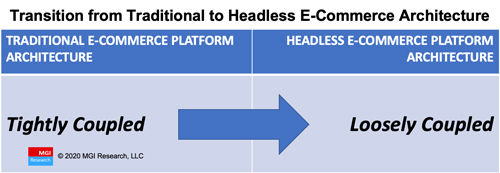E-Commerce platforms are generally viewed as a relatively modern element of an enterprise stack. But in our view, it is one area that is significantly overdue for renovation. In this research note we examine the role that a headless commerce concept can play in helping to modernize e-commerce capabilities.
(Complete report is available to subscribers below)
KEY ISSUES
- How will the e-commerce technology stack evolve?
- What is the business case for headless commerce?
- What are the realistic adoption scenarios for headless commerce?
- Who are the winners and losers in the e-commerce platform market?
For all the talk about omni-channel and e-commerce innovation, most e-commerce operations today are still supported by aging, stove-piped systems that struggle with limited capability, inconsistent back-ends, and high operating costs.
The pace of change in key e-commerce markets such as retail is now exceeding the pace of innovation of the underlying technology. The collapse of the mall as the hub of retail and its rebirth as an experiential destination, retail-as-entertainment (RaE), shift to retail pop-ups, new payment methods, subscription retail and direct-to-consumer custom premium brands, pricing and customer targeting via machine learning and AI, the intersections of online and offline commerce, and the rapid consumerization of B2B are just a few of the highly dynamic trends that are shaping the business and technology priorities in e-commerce.
The majority of the installed e-commerce technology base is aging rapidly and can neither keep up with the emerging requirements of modern retail, B2B, and global commerce players nor serve as an enabler of a sustainable competitive advantage. To a business person, most e-commerce platforms appear as black boxes that provide limited functionality, have many constraints, and require a lot of highly trained experts. In this context, any realistic prospect of higher agility, greater flexibility, and faster time-to-market seems an attractive value proposition.
Among current innovations in e-commerce, headless commerce (HC) is a concept that holds above average potential. HC is a technology architectural concept that effectively decouples e-commerce front-ends that support core presentation from UX functions of back-end components that support core monetization functions such as billing, payments, order management, and provisioning.


